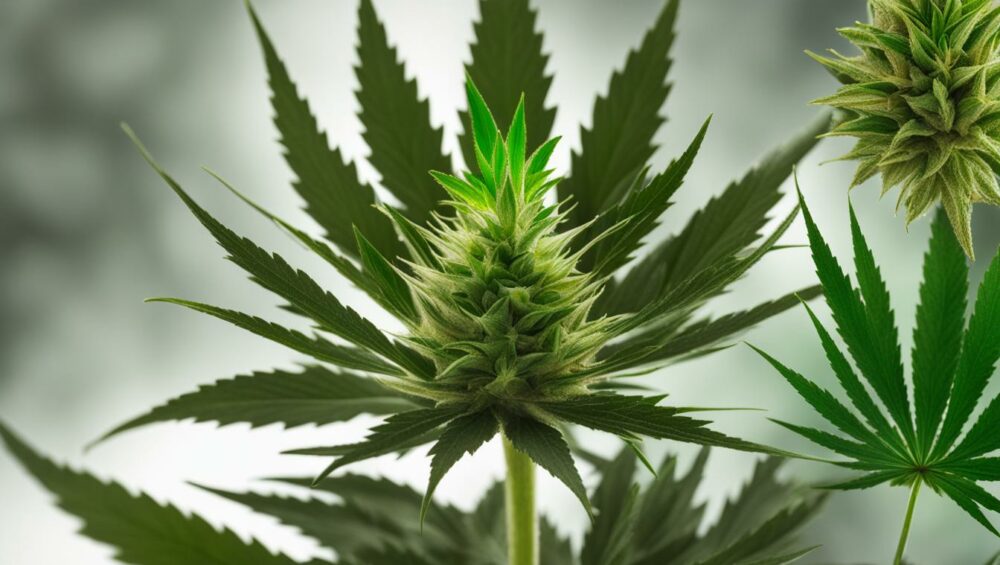Are you curious about the incredible potential of CBD in hemp flowers? Wondering how much CBD is in hemp flower and how it can benefit your wellness journey? Look no further! In this article, we will dive deep into the concentrations of CBD in hemp flowers and explore how you can tap into the amazing benefits it has to offer.
But first, let’s understand what CBD is and how it interacts with our bodies.
So, what exactly is CBD? CBD, or cannabidiol, is a remarkable non-psychoactive compound found in the Cannabis sativa plant. Unlike its cousin THC, CBD does not produce any intoxicating effects, making it a safe and attractive option for consumers.
Recent studies have shown that CBD interacts with our body’s endocannabinoid system, influencing various physiological processes such as mood, sleep, and appetite. This interaction holds immense potential for improving overall well-being and enhancing our quality of life.
Now that we have a basic understanding of CBD, let’s explore the legal landscape surrounding this incredible compound.
Understanding CBD
CBD, or cannabidiol, is one of the many cannabinoids found in cannabis plants. It offers exciting possibilities for wellness without the intoxicating effects associated with THC, another well-known cannabinoid. CBD has gained significant attention in recent years due to its potential therapeutic benefits.
Unlike THC, CBD does not induce a “high” or alter one’s state of consciousness. Instead, it interacts with the body’s endocannabinoid system, a complex cell-signaling network that plays a crucial role in maintaining homeostasis.
The endocannabinoid system consists of two primary receptors, known as CB1 and CB2, which are found throughout the body. When CBD interacts with these receptors, it can influence various physiological processes, such as mood, sleep, and appetite, potentially contributing to overall well-being.
Due to its distinct properties, CBD has been the subject of extensive research and has shown promise in areas such as pain management, anxiety reduction, and epilepsy treatment. However, further scientific investigation is necessary to fully understand CBD’s potential benefits and its impact on specific conditions.
“CBD is a fascinating compound that offers exciting possibilities for wellness without the intoxicating effects of THC. Its interaction with the body’s endocannabinoid system makes it a promising option for various health concerns.”
CBD vs THC
While CBD and THC are both cannabinoids found in cannabis plants, they have distinct effects on the body. The most significant difference between the two is that CBD is non-intoxicating, whereas THC is responsible for the psychoactive effects commonly associated with cannabis.
THC binds directly to the CB1 receptors in the brain, producing euphoria, relaxation, and altering perception. On the other hand, CBD has a weak affinity for these receptors, which is why it does not cause a “high.”
It’s important to note that the legality of THC and CBD varies across jurisdictions. THC is classified as a controlled substance in many places, while CBD, especially when derived from hemp plants containing less than 0.3% THC, is legal in various regions around the world.
CBD and the Endocannabinoid System
The endocannabinoid system (ECS) is a complex network of receptors, enzymes, and endocannabinoids that help regulate various physiological processes in the body. CBD interacts with the ECS by influencing the activity of CB1 and CB2 receptors.
When CBD binds to these receptors, it can modulate neurotransmitter release, reduce inflammation, and affect immune responses. Additionally, CBD may indirectly influence the production and breakdown of endocannabinoids, the body’s natural cannabinoids.
By interacting with the ECS, CBD has the potential to promote balance and support overall wellness. However, researchers are still uncovering the full extent of CBD’s impact on this intricate system and its role in maintaining optimal health.
Legal Status of CBD
Understanding the legal status of CBD is crucial for businesses looking to incorporate it into food products. CBD regulations can vary significantly from one country to another, creating a complex legal landscape. However, in many countries, CBD derived from industrial hemp with less than 0.3% THC is legal.
Industrial hemp refers to varieties of the Cannabis sativa plant that have been specifically bred for industrial uses, such as fiber and seed production. These varieties have low levels of THC, the psychoactive compound found in cannabis, and higher levels of CBD. Due to its low THC content, CBD derived from industrial hemp is considered non-intoxicating and legal in many jurisdictions.
While CBD derived from industrial hemp is generally legal, it’s essential to adhere to specific regulations and requirements for its use. Regulatory authorities may have guidelines on labeling, dosage limits, and testing procedures to ensure product safety and consumer protection.
Businesses looking to incorporate CBD into food products should consult local CBD regulations and comply with all applicable laws. This can involve obtaining necessary licenses, adhering to quality control standards, and conducting relevant testing to ensure compliance and consumer safety. Working with legal professionals and regulatory experts can provide guidance and support in navigating the legal requirements surrounding CBD use.
Despite the legal complexities, incorporating CBD derived from industrial hemp into food products offers significant opportunities for businesses. CBD-infused food items have gained popularity due to the potential therapeutic benefits associated with CBD consumption.
“The legal status of CBD derived from industrial hemp provides an avenue for businesses to tap into the growing demand for CBD-infused food products. However, it’s crucial to understand and adhere to the specific regulations and requirements in each jurisdiction to ensure compliance and consumer safety.” – [Your Name], CBD Regulatory Expert
Consumer demand for CBD in food products continues to rise, and businesses that can navigate the legal landscape and provide high-quality CBD-infused food items have a substantial advantage in the market.
CBD Regulations by Country
| Country | Legal Status of CBD |
|---|---|
| United States | Legal at the federal level if derived from industrial hemp with less than 0.3% THC. State-level regulations may apply. |
| Canada | Legal for both medical and recreational use, including CBD products. |
| United Kingdom | Legal if CBD products meet specific quality and labeling requirements. |
| Australia | Legal with a prescription. Some CBD products available over the counter. |
| Germany | Legal for specific medical purposes, available through pharmacies. |
It’s important for businesses operating in the CBD industry to stay informed about evolving CBD regulations in different jurisdictions. By doing so, they can ensure compliance, maintain consumer trust, and capitalize on the growing demand for CBD-infused food products.
Potential Benefits of CBD in Food Products
CBD has the potential to revolutionize the wellness food industry by offering a range of benefits. As a functional ingredient, CBD enhances the health benefits of food products, providing consumers with an easy and enjoyable way to tap into its therapeutic properties.
One of the key advantages of CBD as a functional ingredient is its potential to promote wellness. CBD has been associated with various health benefits, including alleviating anxiety, reducing inflammation, and improving sleep quality. By incorporating CBD into food products, brands can create wellness foods that support both physical and mental well-being.
In addition to its health benefits, CBD also acts as a natural flavor enhancer in food products. The unique earthy and herbal notes of CBD can complement a wide range of flavors, adding depth and complexity to dishes and beverages. Whether it’s a CBD-infused smoothie, a CBD-infused salad dressing, or a CBD-infused snack, the inclusion of CBD can elevate the overall flavor experience.
The popularity of CBD-infused beverages and snacks is on the rise. CBD has become a sought-after ingredient in the beverage industry, with CBD-infused teas, coffees, and sodas gaining traction. Snacks such as CBD-infused chocolates, gummies, and energy bars have also become popular among wellness-conscious consumers. CBD-infused beverages and snacks offer a convenient and enjoyable way for consumers to incorporate CBD into their daily routines.
Consumers can also personalize their CBD intake through food products. CBD-infused beverages and snacks allow for customizable dosages, enabling individuals to manage their CBD intake according to their wellness goals. Whether someone is looking for a low dose to promote relaxation or a higher dose for more significant benefits, CBD-infused food products offer flexibility and control.
| Benefits of CBD in Food Products | Examples |
|---|---|
| Enhances wellness | CBD-infused health bars |
| Elevates flavor profiles | CBD-infused fruit smoothies |
| Customizable dosages | CBD-infused energy drinks |
The potential benefits of CBD in food products are vast. However, it’s essential for brands to ensure the quality and consistency of CBD-infused food products. Rigorous testing and adherence to regulatory guidelines are crucial to delivering safe and effective CBD experiences to consumers.

Challenges and Considerations
Incorporating CBD into food products presents several challenges that businesses need to navigate. From regulatory hurdles to ensuring consistency and stability, there are important considerations to keep in mind. Additionally, consumer education about CBD is crucial to provide clear information and address any misconceptions.
Regulatory Hurdles for CBD
The regulatory landscape surrounding CBD is complex and continues to evolve. Businesses must stay updated on the latest regulations to ensure compliance when incorporating CBD into food products. This includes understanding the guidelines for sourcing CBD, labeling requirements, and permissible dosages.
Consistency and Stability of CBD in Food Products
Achieving consistent CBD content and maintaining stability in food products can be challenging. CBD may degrade or lose potency when exposed to heat, light, or oxygen. Businesses need to implement quality control measures and proper formulation techniques to ensure that the CBD content remains consistent throughout the product’s shelf life.
Consumer Education about CBD
Clear consumer education about CBD is essential to address any misconceptions and ensure responsible usage. It’s important to provide accurate information about CBD’s potential benefits, proper usage, and legal aspects. Educating consumers allows them to make informed decisions and feel confident in incorporating CBD into their wellness routines.
The Future of CBD in Food Products
The potential of CBD in food products is vast. It offers opportunities for functional enhancements, unique flavor profiles, and customizable dosages. As the industry continues to explore and refine CBD applications, businesses must prioritize quality control, navigate regulatory challenges, and invest in consumer education.
With the growing demand for wellness-focused products, incorporating CBD into food products allows businesses to tap into the potential of this natural compound. CBD can be a valuable addition to functional foods, providing consumers with the benefits of CBD while enjoying their favorite culinary experiences.
One area of innovation lies in the development of novel and innovative CBD formulations. Businesses can explore various extraction methods and formulation techniques to create unique CBD-infused products that cater to different consumer preferences. From CBD-infused chocolates and gummies to beverages and snacks, the possibilities are endless.
Consumer preferences play a significant role in shaping the future of CBD in food products. As people seek wellness and holistic approaches to their daily routines, they are increasingly looking for products that align with their lifestyle choices. CBD-infused food products provide an avenue for consumers to incorporate CBD into their wellness journey in a convenient and enjoyable way.
To fully leverage the potential of CBD in food products, businesses must prioritize quality control. Ensuring consistent CBD content and stability is crucial in delivering reliable and effective products to consumers. This requires careful sourcing of high-quality CBD extract and rigorous testing throughout the production process.
The regulatory landscape surrounding CBD can be complex, with varying regulations across different jurisdictions. To navigate these challenges, businesses need to stay updated on legislative changes and comply with the relevant regulations. Adhering to labelling requirements, understanding permissible CBD concentrations, and staying informed about the legal status of CBD in different regions are essential for successful integration into the food industry.
Investing in consumer education is paramount in fostering trust and understanding of CBD in food products. Many consumers may have misconceptions or uncertainties about CBD, its benefits, and its legal status. By providing accurate information, clear labelling, and educational resources, businesses can help consumers make informed choices and embrace the potential of CBD in food products.
In summary, the future of CBD in food products holds great promise. From functional enhancements to unique flavor experiences, CBD offers a myriad of possibilities for culinary innovation. As businesses continue to explore novel formulations, prioritize quality control, and invest in consumer education, they can meet the growing demand for wellness-focused food products.
Advantages of CBD in Food Products:
- Functional enhancements for wellness
- Unique flavor profiles
- Customizable dosages
- Meeting consumer preferences for holistic experiences
Challenges and Considerations:
- Complex regulatory landscape
- Consistent CBD content and stability
- Consumer education on CBD
Potential CBD-Infused Food Products
| Product Category | Description |
|---|---|
| Functional Foods | Wellness-enhancing CBD-infused snacks, energy bars, and meal replacements |
| Beverages | CBD-infused teas, coffees, waters, and juices for relaxation and well-being |
| Bakery and Confectionery | CBD-infused chocolates, cookies, pastries, and desserts for indulgence with added benefits |
| Sauces and Condiments | CBD-infused dressings, marinades, and spreads to elevate flavor profiles |
Conclusion
CBD’s potential in food products is nothing short of revolutionary. With its ability to provide functional benefits, enhance flavors, and offer customizable dosages, CBD opens up a world of possibilities for the food industry. By harnessing the full potential of CBD, businesses can meet the evolving preferences of consumers seeking both wellness and culinary experiences.
Navigating the regulatory challenges associated with CBD is crucial for businesses looking to incorporate it into food products. By ensuring compliance with changing regulations, companies can confidently bring CBD-infused products to market, offering consumers a new and exciting way to incorporate CBD into their daily routines.
Quality control is another essential aspect to consider when unlocking the full potential of CBD in food products. Consistency and stability in CBD content are important for delivering reliable and effective products to consumers. By prioritizing rigorous quality control measures, businesses can provide their customers with the confidence they deserve.
Equally important is the need for consumer education about CBD. Providing clear and accurate information about CBD’s benefits, usage, and legal aspects is essential for building trust and confidence. By educating consumers, businesses can help demystify CBD and empower individuals to make informed choices about their wellness journey.
FAQ
How much CBD is in hemp flower?
The concentration of CBD in hemp flower can vary, but it typically ranges from 10% to 20%.
What is CBD?
CBD, or cannabidiol, is a non-psychoactive compound found in the Cannabis sativa plant. Unlike THC, it does not induce a “high” and has potential therapeutic benefits.
What is the legal status of CBD?
The legal status of CBD varies globally. In many countries, CBD derived from industrial hemp with less than 0.3% THC is legal. However, regulations can differ, and businesses must navigate a complex legal landscape when incorporating CBD into food products.
How can CBD be used in food products?
CBD can be used as a functional ingredient in wellness foods due to its health benefits. It can also enhance flavors in food products and has gained popularity in beverages and snacks.
What are the challenges of incorporating CBD into food products?
Incorporating CBD into food products comes with challenges. The regulatory landscape for CBD is complex and evolving, requiring businesses to ensure compliance. Achieving consistent CBD content and stability in food products can be challenging. Furthermore, consumer education is essential in providing clear information about CBD’s benefits, usage, and legal aspects.
What is the potential of CBD in food products?
The potential of CBD in food products is vast. It offers opportunities for functional enhancements, unique flavor profiles, and customizable dosages. As the industry continues to explore and refine CBD applications, businesses must prioritize quality control, navigate regulatory challenges, and invest in consumer education.
How can businesses tap into the full potential of CBD in food products?
Businesses can tap into the full potential of CBD in food products by ensuring product quality, navigating regulatory challenges, and investing in consumer education. By doing so, they can meet the evolving preferences of consumers seeking wellness and culinary experiences.







